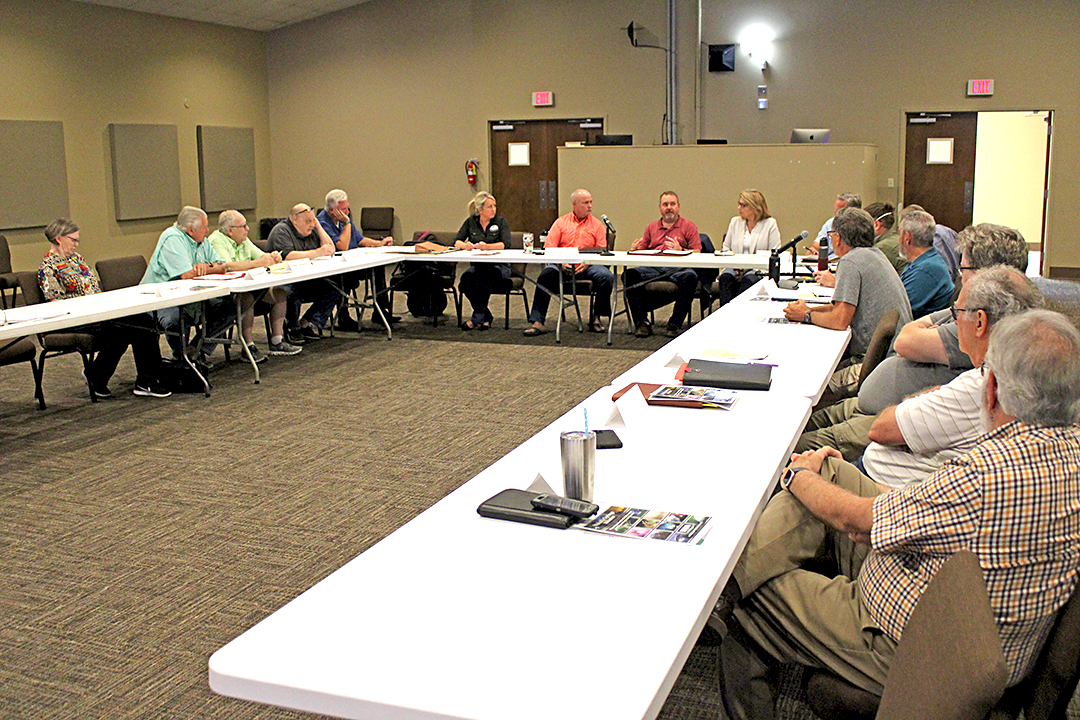COMMUNITY
- COMMUNITY HOME
- CHARTER REVIEW DISCUSSES SPRING PROTECTION
- ST. MARKS TO RAISE SEWER RATES 75% ON RESIDENTS
- ROBYN HURST REMEMBERED
- THE CHILL SPOT
- 4-H ANNOUNCES SUMMER YOUTH LEADERSHIP COHORT
- JENNIFER PHILLIPS OF NORTH FLORIDA LEARNING WINS BUSINESS AWARD
- HURRICANE AWARENESS SEMINAR SET AT MACEDONIA
- SCOT BENTON FINISHES FIRST IN CHALLENGE
- FLORIDA WILD MAMMAL BRINGS THE CRITTERS
- ON THE HORIZON
- LIBRARY NEWS
- BUCKHORN NEWS
- WAKULLA STATION NEWS
- CHAMBER NEWS
CHARTER REVIEW DISCUSSES SPRING PROTECTION

Members of the Charter Review Committee at a meeting last week at the community center.
By WILLIAM SNOWDEN Editor
The Wakulla Springs Alliance made a pitch to the county’s Charter Review Committee for a proposed ballot initiative that would expand the Wakulla Springs protection area or create a Spring Creek special planning area.
The Charter Review Committee has been meeting over the past few months to look at possible changes to the county’s governing document. It is required to be reviewed every 10 years.
Chad Hanson, a member of the Wakulla Springs Alliance, did a PowerPoint presentation at the Charter Review Committee’s meeting on Tuesday, June 6 at the community center.
Hanson’s presentation went through the historical degradation of the springs due to nitrogen in groundwater from septic systems and the City of Tallahassee’s Tram Road sprayfield. It reached the point in 2008 that the state Department of Environmental Protection deemed the Wakulla River “biologically impaired.”
Hanson noted that there has been some recovery in recent years, “but it’s nowhere near where it should be.”
The implications of expanding the zone would be, for vulnerable areas in the basin map, which includes much of Crawfordville:
• Require advanced wastewater treatment standards for septic tanks, with sewer preferred;
• Low impact development such as two units per acre on septic, or no more than five units on sewer;
• and no Future Land Use Map amendments for more than 1 unit on 2 acres (on sewer) or 1:5 (OSTDS) without enforceable development agreement.
Some members of the Charter Review Committee questioned if expanding the springs protection zone was an appropriate issue – with committee member Andrew Riddle, who also chairs the county planning commission (of which Hanson is also a member), asked if it wasn’t more properly an issue to be addressed in the county’s comprehensive plan. Riddle also questioned the impact of such a change on county building regulations.
Committee member John Shuff noted that the Wakulla Springs basin encompasses 1,300 square miles – much of which is in Leon County – and questioned why Leon doesn’t help shoulder the burden of cleaning up the 7,000 septic tanks in its jurisdiction.
Committee member Lynn Artz went forward with a motion to approve the expansion of the springs protection zone as a ballot question – and the motion was seconded by committee member David Damon.
Committee Chair Chris Russell expressed disappointment at the motion and said it should properly be brought up on next month’s agenda as new business. Artz withdrew her motion.
At the end of the meeting, County Administrator David Edwards expressed his opinion that expansion of the springs protection zone would have major implications. He pointed to the impact on the Crawfordville Town Plan and said the change would take the county’s zoning regulations and toss them out the window.
“It would paralyze the county from a growth perspective,” Edwards said.
The issue of DEP shutting down the county’s proposed springs protection ordinance that had been brought up the night before at the county commission meeting drew strong reactions:
Riddle, who was in the audience at the commission meeting, was recounting the announcement by Edwards that the state agency would deny any effort by the county to pass the more restrictive ordinance on siting underground storage tanks for gas stations.
Charter review committee member Pete Scalco became very upset, denying that DEP has any authority to oversee county ordinances.
Later in the meeting, Damon seemed to question Edwards’ veracity about DEP’s stance and said he wanted to see it in writing.
Edwards responded that some DEP staff were confounded by objections by local environmental activists, such as Damon, to the proposed ordinance. Edwards recounted that he told the DEP staff that it’s like living in Opposite Land.
Edwards said county staff had worked hard on the ordinance to protect groundwater while Damon worked against them.
Damon angrily retorted that Edwards and staff were keeping citizens out of the process by not holding workshops.
The exchange ended when Russell, the committee chair, called for a motion to adjourn.
